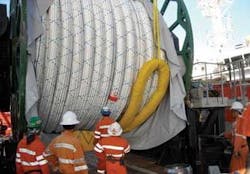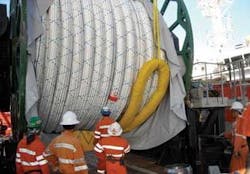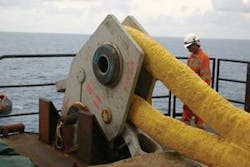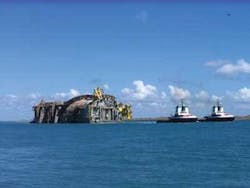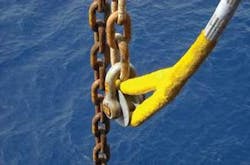Shell’s Perdido sets mooring record
Tracy Dulle - Technology Editor, Surface Systems & Vessels
Shell’s Perdido Development project’s drilling and production facility will be the deepest in the world when it begins producing around the turn of the decade. The direct vertical access (DVA) spar is moored in about 8,000 ft (2,438 m) of ultra deepwater in Alaminos Canyon block 857 near the Great White discovery in the Gulf of Mexico.
With the increased water depth at Perdido comes additional challenges due to extreme water pressure and cold temperatures, and extreme marine conditions such as wind, waves, currents, and seasonal tropical storms. The site is remote and is located in ultra deep waters from about 7,500-10,000 ft (2,286-3,048 m), with rugged seafloor terrain.
Heerema Marine Contractors set a world record in installing the world’s deepest permanent mooring anchor pile when, on June 23, 2008, Perdido anchor pile P6 was installed in 8,631 ft (2,632 m) of water using the deepwater crane vessel (DCV)Balder.
The success of this operation has been possible thanks to the state-of-the-art competence achieved by using technology based on utilizing remotely operated vehicles (ROVs), mounted suction pile pumps, and the Balder Mooring Line Deployment Winch (MLDW), according to Heerma.
Using polyester
The Perdido mooring system comprises nine chain/polyester lines averaging more than 2 mi (3 km) in length, with a vast majority of the lines being polyester. The nine taut lines are configured in a 3 x 3 pattern and consist of 9.68-in. (24.6-cm) polyester rope main sections, short lengths of 5.28-in. (13.4-cm) chain at each end of the mooring lines, and 18-ft (5.5-m) O.D. suction piles. “This is Shell’s first use of a polyester mooring system for a permanent floating production system following Shell’s previous experience with polyester mooring systems for deepwater drilling rigs in the GoM and a deepwater CALM buoy offshore Nigeria,” says Curtis Lohr, Perdido Spar & Mooring project manager.
Polyester puts less vertical load on a floating structure, which results in less payload requirement on the structure. “Polyester mooring lines provide the benefit of reducing the payload required for the Perdido spar while meeting the 1,000-year storm design requirements,” Lohr says.
“We feel the industry has progressed well over the years and have full confidence in the reliability of polyester mooring systems,” Lohr adds. At Perdido, roughly 1,100 ft (335 m) of each mooring line is chain at the top and the bottom, while polyester makes up roughly 11,000-12,000 ft (3,353-3,658 m).
“There’s the potential for abrasion on the seafloor so we have a short length of chain on the ground, and we designed the mooring system so the polyester should never touch the seafloor,” Lohr says. “However, the polyester rope is jacketed to protect against abrasion in case the polyester were ever to contact the seafloor. Also, because the spar has chain jacks on top that allow the spar to be repositioned--chain handles better than polyester in a winch.”
Getting into position
In August, the spar was towed 160 nautical mi and then upended – rotated from a horizontal to a vertical floating position – before being moored to the seafloor anchor piles, which were installed on site in June of 2008.
Heerema towed the spar to the Perdido site in wet conditions using two large tugs. Once on site, water was pumped through hoses attached to the top of the spar to rotate it to a vertical position.
Initially getting the spar vertical was done by putting water in the lower tanks. In order to get the spar to the designed operating draft, a heavy iron ore material, which will remain permanent, was pumped into the lower tanks.
Perdido achieved a milestone on Aug. 18. “To be storm-safe by the middle of August was a significant goal at the beginning of the project, so we’re really pleased at being able to make that milestone which involved having the spar and mooring system ready on time,” Lohr says.
Storm- safe for Perdido meant having three mooring lines installed—at that point it can withstand a minor hurricane. By the end of August all nine lines were installed. The spar is designed to survive a 1,000-year hurricane, which is based on the updated metocean criteria following the devastating storms seen over the past few years, Lohr says.
Perdido is an active mooring system. “We’re able to move the spar to a 300-ft (91-m) offset, which enables us to install subsea trees and to facilitate the subsea jumper installation.”
Subsea components
This will be the first application of full host-scale subsea separating and boosting, which enables improved recovery by removing about 2000 psi of back pressure from the wells.
It also will be the first application of wet tree DVA wells from a spar. Using a DVA configuration allows a larger number of subsea completions to be accessed by the facility’s drilling rig, resulting in significant savings in the drilling and completions programs for these wells.
The wet tree DVA system will use a single high pressure drilling and completion riser suspended from the host to access 22 subsea trees directly below the host. The configuration will allow the use of a surface blow-out preventer (BOP) for the drilling, completion, and later sidetracking of wells. By using a single well slot for accessing the wells beneath the host, the size and cost of the host can be reduced without limiting well count flexibility, which is important given the increasing subsurface challenges in a maturing deepwater environment.
Incorporation of newly developed procedures for drilling and completing wells with a surface BOP and installing subsea trees will be the key to efficient operations from the fit-for-purpose platform drill rig.
Preparing for installation
A lot of advanced planning by Heerema and the Perdido installation team went into the offshore installation program and a lot of watching the weather took place, particularly when installation was in the middle of hurricane season in the Gulf of Mexico.
There were three storms that impacted the 2008 installation campaign:
- Hurricane Dolly came ashore in south Texas near Corpus Christi in July causing a delay in the spar make-ready schedule. Extensive efforts were made to ensure the spar was ready to sail as soon as possible in order to meet the project goal of being storm safe by mid-August.
- For Hurricane Gustav, all nine of the spar mooring lines were installed by the time this hurricane passed over the Perdido site in early September. Equipment was secured on top of the spar and evacuations were made in preparation for the hurricane. There was no damage to the spar.
- For Hurricane Ike, the fixed ballast was installed just prior to evacuating the Perdido site in mid-September for this hurricane.
Perdido will provide production processing for three fields: Great White, Silvertip, and Tobago. The concept for regional development includes a common processing hub that incorporates drilling capability and functionality to gather, process, and export production within a 30-mi (48-km) radius of the facility. This concept will provide regional synergies, reduced cost, and lower risk.
Perdido will be capable of delivering 130,000 boe/d (100,000 bbl of oil and 200 MMcf/d of gas). The Perdido spar, which is nearly as tall as the Eiffel Tower with its topsides and rig, is moored on location awaiting installation of the topsides in 2009.
It is scheduled to begin production around the turn of the decade.
Shell is 35% owner/operator of the Great White, Silvertip, and Tobago fields and the Perdido Regional Host Spar, while Chevron has 37.5% and BP 27.5%.
